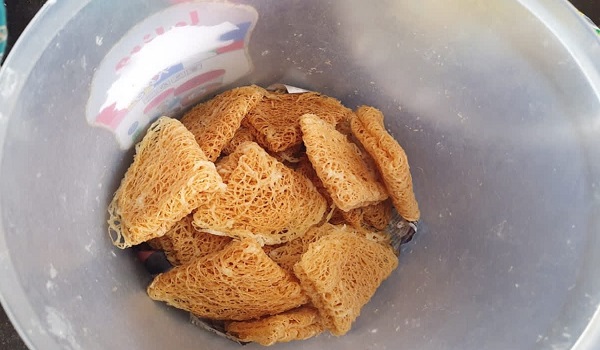In the heart of Sambalpur, a quiet culinary ritual unfolds as evening descends on Kunjalpada Chowk. A small stall draws a loyal crowd at exactly 7 PM, lured by the subtle, earthy aroma of a rare and centuries-old sweet, Sarasatiya. Crafted from the extract of forest tree branches, this unique triangular delicacy has been handmade by a single family in Odisha for over 160 years.
Sarasatiya is no ordinary sweet. Made from the juice of Ganjar tree branches sourced from the nearby Bara hills, the extract is soaked, crushed, and blended with rice flour, jaggery, and sugar to create a smooth batter. This batter is hand-flicked into hot oil, where it crisps into fragile, golden pieces that resemble delicate triangles—light, crunchy, and quick to melt in the mouth. Its taste is an intricate harmony of jaggery, forest essence, and subtle caramel notes—completely free of preservatives or artificial flavouring.
The sweet’s signature fragility has earned it a local nickname: the “touch-me-not” sweet. It’s delicate enough to break with a soft hold, yet resilient in its deep connection to Sambalpur’s culinary identity.
Despite its popularity and consistent demand, Sarasatiya has never been commercially scaled. The Gupta family, led by fifth-generation sweet-maker Prabhulal Gupta—affectionately known as Minchu Kaka—continues to preserve the recipe as a sacred family tradition. Around 600 pieces are made and sold daily, priced modestly at Rs. 12 each, even as ingredient costs rise.
Production remains a family affair, with every member contributing. The process is considered a ritual, more akin to preparing prasad than a snack. Locals often purchase Sarasatiya to offer to deities, and the family refuses to industrialize or franchise the sweet, determined to maintain its authenticity.
The sweet has also drawn notable admirers, including politicians and dignitaries. Yet, despite wide appreciation and media attention, Sarasatiya is still awaiting a GI (Geographical Indication) tag—a legal certification that would help preserve and promote its heritage nationally.
Sambalpur’s District Magistrate, Siddheshwar Baliram Bondar, has acknowledged the sweets’ cultural and therapeutic value. With its natural ingredients and no added sugar, Sarasatiya is even considered a safe indulgence for diabetics. The district administration is now exploring ways to provide official recognition, preserve the tradition, and enable knowledge transfer without compromising on its authenticity.
More than just a sweet, Sarasatiya is a living legacy—an edible heritage that continues to thrive through memory, craftsmanship, and forest wisdom


